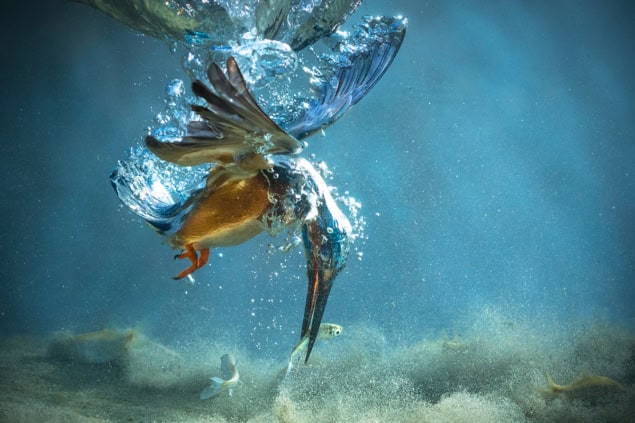David Norman reviews The Physics of Birds and Birding: the Sounds, Colors and Movements of Birds, and Our Tools for Watching Them by Michael Hurben

Lots of people like birds. In Britain alone, 17 million households collectively spend £250m annually on 150,000 tonnes of bird food, while 1.2 million people are paying members of the Royal Society for the Protection of Birds (RSPB), Europe’s largest conservation charity. But what is the Venn diagram overlap between those who like birds and those who like physics?
The 11,000 or more species of birds in the world have evolved to occupy separate ecological niches, with many remarkable abilities that, while beyond human capabilities, can be explained by physics. Owls, for example, detect their prey by hearing with asymmetric ears then fly almost silently to catch it. Kingfishers and ospreys, meanwhile, dive for fish in freshwater or sea, compensating for the change of refractive index at the surface. Kestrels and hummingbirds, on the other hand, can hover through clever use of aerodynamics.
Many birds choose when to migrate by detecting subtle changes in barometric pressure. They are often colourful and can even be blue – a pigment that is scarce in nature – due to the structure of their feathers, which can make them appear kaleidoscopic depending on the viewing angle. Many species can even see into the ultraviolet; the blue tits in our gardens look very different in each other’s eyes than they do to ours.
Those of us with inquisitive minds cannot help but wonder how they do these things. Now, The Physics of Birds and Birding: the Sounds, Colors and Movements of Birds, and Our Tools for Watching Them by retired physicist Michael Hurben covers all of these wonders and more.
Where are the birds?
In each chapter Hurben introduces a new physics-related subject, often with an unexpected connection to birds. The more abstruse topics include fractals, gravity, electrostatics, osmosis and Fourier transforms. You might not think quarks would be mentioned in a book on birds, but they are. Some of these complicated subjects, however, take the author several pages to explain, and it can then be a disappointment to discover just a short paragraph mentioning a bird. It is also only in the final chapter that the author explains flight, the attribute unique among vertebrates to birds (and bats).
The antepenultimate chapter justifies the second part of the book’s title – birding. It describes the principles underlying some of the optical instruments used by humans to detect and identify birds, such as binoculars, telescopes and cameras. The physics is simpler, so the answers here might be more familiar to non-scientist birders. Indeed, focal lengths, refractive indices, shape of lenses and anti-reflection coatings, for example, are often covered in school physics and known to anyone wearing spectacles.
Unfortunately, Hurben has not heeded the warning given to Stephen Hawking by his editor of A Brief History of Time, which is that each equation would halve the book’s readership. That masterpiece includes only the single equation, which any physicist could predict. But The Physics of Birds and Birding sets the scene with seven equations in its first chapter, and many more throughout. While understanding is helped by over 100 small diagrams, if you’re expecting beautiful photos and illustrations of birds, you’ll be disappointed. In fact, there are no images of birds whatsoever – and without them the book appears like an old fashioned black-and-white textbook.
Physicist or birder?
The author’s interest in birds appears to be in travelling to see them, and he has a “life-list” of over 5000 species. But not much attention in this book is paid to those of us who are more interested in studying birds for conservation. For example, there is no mention of thermal imaging instruments or drones – technology that depends a lot on physics – which are increasingly being used to avoid fieldworkers having to search through sensitive vegetation or climb trees to find birds or their nests. Nowadays, there are more interactions between humans and birds using devices such as smartphones, GPS or digital cameras, or indeed the trackers attached to birds by skilled and licensed scientists, but none of these is covered in The Physics of Birds and Birding.
Although I am a Fellow of the Institute of Physics and the Royal Society of Biology who has spent more than 50 years as an amateur birder and published many papers on both topics, it is not clear who is the intended target audience for this volume. It seems to me that it would be of more interest to some physicists who enjoy seeing physics being applied to the natural world, than for birders who want to understand how birds work. Either way, the book is definitely for only a select part of the birder-physicist Venn diagram.
- 2025 Pelagic Publishing 240pp £30 pb; £30 ebook



